Peru in the time of Corona Virus
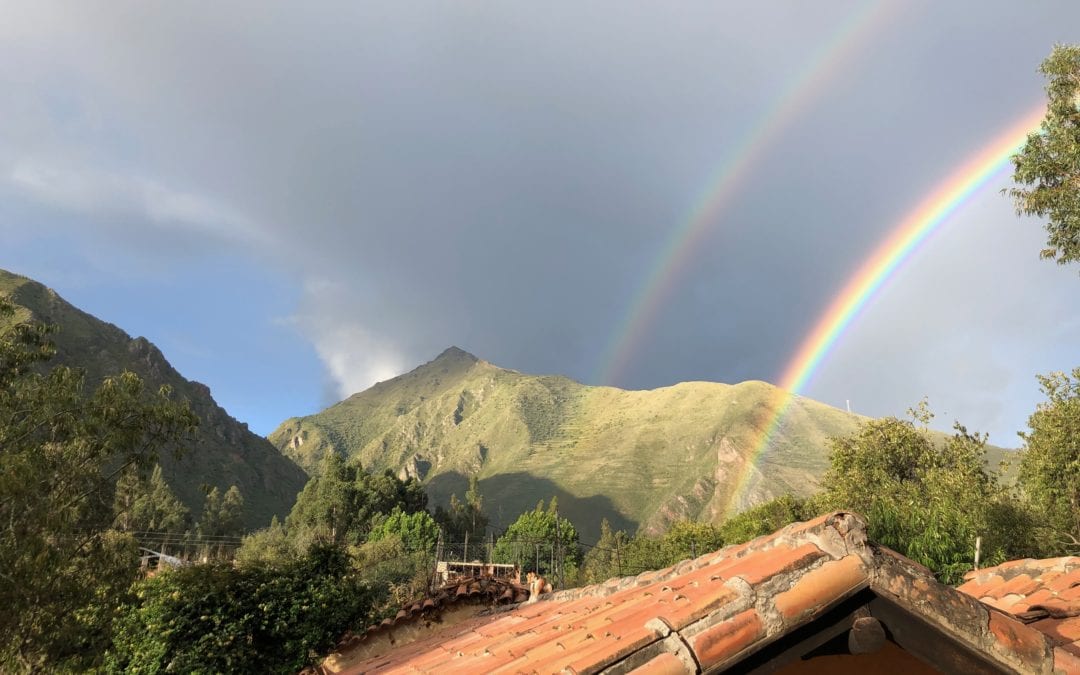
See Below For Most Recent Updates….
Willka Tika Covid Protocols Summary
Willka T’ika Covid Protocol Video
State of Emergency
Monday March 16: Quarantine in Peru
Early today, Peru’s government announces that due to the Corona virus international flights will stop at midnight and quarantine in Peru will begin. All borders will close. Over breakfast, I discuss options with a group of women and one child who are finishing up a week long “Pachamama Program” at Willka T’ika. I warn them that if they want to avoid being stranded in Peru, we should find them a flight to Lima ASAP so that they can catch one of the few international outbound flights to the US. The group unanimously decides that they would much rather stay at Willka T’ika than join the hordes of expats try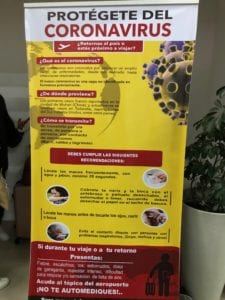 ing to leave the country. I assure them that Willka T’ika will provide basic food and services for the next two weeks considering that all Peruvians have been ordered to stay home from work. One of the older women, tears up “Thank you for taking care of us. I feel so much safer here and I can’t imagine being stuck in Lima now.” I call an urgent staff meeting with our 19 Quechua staff, many who live only a few hundred meters away from Willka T’ika. We all agree that taking care of our guests and our own health is our top priority. The staff volunteer to rotate each day, sending one person in the daytime to help me with cooking and one person at night to provide security.
ing to leave the country. I assure them that Willka T’ika will provide basic food and services for the next two weeks considering that all Peruvians have been ordered to stay home from work. One of the older women, tears up “Thank you for taking care of us. I feel so much safer here and I can’t imagine being stuck in Lima now.” I call an urgent staff meeting with our 19 Quechua staff, many who live only a few hundred meters away from Willka T’ika. We all agree that taking care of our guests and our own health is our top priority. The staff volunteer to rotate each day, sending one person in the daytime to help me with cooking and one person at night to provide security.
Our guide Silverio arrives to share the latest news from Cusco. Roads are still open to cars but that will stop tonight. We tell our guests that if they want to get out and see some Incan ruins, today will be their only chance. They will no longer be able to go to Machu Picchu tomorrow as planned. So we drive across the Sacred Valley to P’isaq which looks like a ghost town. The ruins are closed and the usually crowded tourist market is eerily empty. Police have begun patrolling and telling merchants to close their stores. We are still allowed to walk around and ask a woman to open her empanada restaurant so we can eat our last meal out for at least the next two weeks. I check our stocks of food – Antonia and I had recently been shopping in Cusco and stocked up on staples (and hand sanitizer) before things got crazy. We fortunately have plenty of rice, lentils, beans, quinoa, pasta, cooking oil, vinegar, tea, coffee, powered and canned milk. For the first time, I lock the pantry door. There are stories of locals shutting their stores and buying up all the rice and sugar. At least toilet paper is still plentiful in Peru!
\
Tuesday March 17:
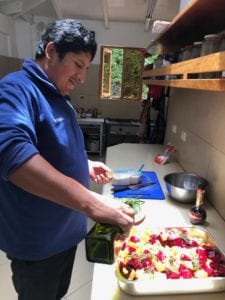
Day 1 of a 15 day quarantine officially begins. I take our dogs, Apu and Kallpa, on a short work around the neighborhood of Rumichaka to see how the quarantine in Peru is shaping up. Children are playing soccer on the empty main street. It reminds me of how the Sacred Valley used to look two decades ago: no traffic, no sounds of motors, no construction. Tristen and I walk to her Spanish teacher’s house, an elderly woman who would be at high risk for COVID-19. We ask her if she needs help with groceries or going to the bank and she requests only sweet potatoes for her dogs. The bank, some markets, and emergency services are still open but Peruvians are instructed to travel alone, with ID, wearing face masks, and only when necessary. There are almost no moto-taxis on the streets so locals are doing their errands on foot. Julio César, a young college student who is part of the Willka T’ika Children’s Fund decides he would prefer to “shelter in place” at Willka T’ika rather than return to his Andean community of Chumpe Pokkes. He will weed the vegetable garden during the day and help us in the kitchen in the afternoon. The cash he earns from us this month will feed his family for the year. A strange foreigner knocks at the door of Willka T’ika asking if we have rooms for rent. I tell Julio not to let anybody unknown into Willka T’ika and to tell anyone who asks that we are “bajo cuarentena” and no longer open to new guests. Florencio, our head chef comes to help in the kitchen and helps me make a simple lunch of root stew. For dinner we prepare quinoa patties, salsa de rocoto, and sweet potato purée.
Wednesday March 18:
Corona-virus has now arrived to the Sacred Valley. Apparently, two tourists have brought the virus to Machu Picchu, Cusco, and the Sacred Valley. After a brief yoga practice and a cup of Quillabamba coffee, I attempt to get some work done. I can’t seem to concentrate on any work outside of the new reality in front of me. So I spend the morning harvesting basil, tomatoes, beets, carrots, chard, spinach, arugula, lettuce, and cabbage from the garden. This is my second day working in the kitchen and I’m embracing the opportunity to be hands-on with all elements of our meal preparation. Today, Antonia and I make fresh pesto and prepare spinach soup for dinner. Then as she bakes an apple pie, I sauté up some cabbage and potatoes for lunch. The guests are very happy to have lunch as it is normally not provided. They want to help, so I show them around the vegetable gardens in case they feel inspired to help harvest (or weed). Apu and Kallpa break quarantine and bolt out the front door when I open it walk to the vegetable garden. Too tired to chase them, I fetch a whistle from my house and blow twice loudly. The dogs reappear after a few minutes, panting from their mischievous escape. This is the first time they have ever run away — they must have picked up on something strange in the air.
Thursday March 19:
I do my daily yoga practice alone in our sun-room, and avoid leaving the property, even to walk the dogs. I’m sure it would safe to do so but it feels more responsible to just stay here. Today is the autumnal equinox and the leader of the group leads her participants in a special meditation in the garden. After preparing a quinoa soup and roasted vegetables for dinner, Arturo and I bake a chocolate cake for a woman in the group who is celebrating her birthday today. Arturo is our best cake maker and I’m amazed to watch him work. He does everything by “feel” and barely measures the flour. He even determines the temperature of the oven by looking at the size of the flames. I help him make the frosting and decorate the cake with calendula petals from the garden. The guest is delighted with the cake, the gifts from the group, and the Kintu coca leaf blessing that Livio and I give her. Bottles of wine are opened. While the guests are celebrating, I catch up on the news. The first fatalities of COVID-19 have come to Peru. I send an urgent Whatsapp message to our staff to stay home.
Friday March 20:
Marta comes to help me in the kitchen. With most of her days spent doing laundry, Marta is the least confident staff member when it comes to food preparation. So I take the lead on lunch (tortilla española) and we settle on a simple dinner of pumpkin soup and chard pancakes. The youngster of the group, has been happily entertaining herself all week, playing with our dogs, chasing hummingbirds, and looking for young Lucuma saplings. I notice that her dependence on her electronics is minimal, and her mother explains that she is used to home schooling and playing by herself. She reminds me of my pre-internet Generation X childhood and an article I read today about how Generation X is best prepared for a quarantine, since we grew up as latch key kids! I take her to our vegetable gardens to show her how to find huacatay, cilantro, rocoto, and sacha tomato so that we can make an ají sauce to pair with steamed potatoes. Marta may be unsure about how to cook rice but she whips up a delicious ají without a thought. The group continues to enjoy the gardens and today each person chooses one of the Seven Chakra Gardens to find inspiration. One woman, a best-selling author, decides that she will write another book. This time it will be about Pachamama, Mother Earth and her role in healing the Earth. I couldn’t imagine a better time for such a book.
Saturday, March 21:
Each day I decide to call one friend or family member. It really helps elevate my mood and I know that most people are home sheltering-in-place and happy to hear from. My friends seem mostly stressed about home schooling their kids, which I find bizarre, considering what is happening in the world. A grad school ex-military classmate sends an apropos post on Whatsapp: “Your grandparents were asked to go to war. You’re being asked to sit on the couch for two weeks. You can do this!” My family is calm and we share information over Whatsapp. For the first time, I start to understand why some people believe in dystopian conspiracy theories. Times like these are perfect for authoritarian sympathizers and elitists. Technological tracking of people, mandatory vaccines, military occupation, special presidential powers, and even a cashless economy all start to sound more menacing. Although I’m personally glad to see the Peruvian military in the streets, I can see why others are worried about a Hunger Game world. I decide not to listen the news. There is enough darkness out there and Willka T’ika needs to remain a place of love, joy, peace, and hopefully truth.
Sunday, March 22:
It’s been a week since the state of emergency and today is the first day I’ve managed to do any administrative work. Mundane normalcy and productivity feel reassuring. I leave the office only to take a few personal phone calls. Tristen has called some of my favorite people around the world to see how they are doing. She knows this is the only way to get me away from my computer. Our friends in Europe regale us with an inspiring story of how they caught the last flight to France, arriving in Marseilles to an empty rental car lot and persuading a gendarme that their home was in Provence. One of them feels conflicted about leaving her family behind in California. We reassure her that she is better off in a quiet, healthy place away from the frenetic, anxious energy of a densely populated city. That’s how we feel here in the Sacred Valley, the best place in quarantined in Peru.
It feels satisfying to be in in kitchen providing food for myself, my wife, my guests, and even my staff. I’ve even been able to teach the staff a few of my favorite recipes and techniques. Besides learning how they each cook (very differently) and prep (very skillfully) and measure (very randomly), I have a deeper appreciation for why the food we serve tastes so good. It really is made with love. I’ve also learned that Florencio needs a new peeler, Antonia needs a knife sharpener, and Arturo needs a new lighter for the oven. They’re so used to working in their way, that they don’t even know they need these things! If I’m not able to get any other work done, then I will cook my way through this quarantine.
Monday, March 23:
One of our more adventurous 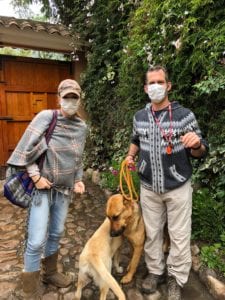 has been asking me to take her to town all week. Until today I didn’t really have the energy, or the need, to break our quarantine. But today, we are getting low on a couple supplies and I really need to go to the bank. So I outfit us both with face masks, gloves, government IDs, and hand sanitizer and we begin the 40 minute walk to Urubamba. At first, we consider taking the dogs who are desperate to be walked. But Arturo convinces us that the military are blocking the main road into town and that my urgent need to go to town will be sound less compelling if I’m walking my dogs. The roads are empty and the only vehicles I see are a cargo truck and a couple bicycles. A few people cross our path as we walk down the main road, half of them look like foreigners. I make a point to greet everyone we see, despite the fact that we all have our faces pointing towards the ground. People greet us back but only one person smiles. Thirty minutes later, we approach the road block and a tall, imposing policeman asks me what I’m doing walking to town. I show him my empty grocery back and mention the market, adding that I also need to go the bank. He tells me sternly that the market is now closed. I should not have waited until 10AM to do my shopping. I mention the bank again and add that I have to pay my staff. He motions me forward. “Please be as fast as you can.” I thank him and walk past the barricade.
has been asking me to take her to town all week. Until today I didn’t really have the energy, or the need, to break our quarantine. But today, we are getting low on a couple supplies and I really need to go to the bank. So I outfit us both with face masks, gloves, government IDs, and hand sanitizer and we begin the 40 minute walk to Urubamba. At first, we consider taking the dogs who are desperate to be walked. But Arturo convinces us that the military are blocking the main road into town and that my urgent need to go to town will be sound less compelling if I’m walking my dogs. The roads are empty and the only vehicles I see are a cargo truck and a couple bicycles. A few people cross our path as we walk down the main road, half of them look like foreigners. I make a point to greet everyone we see, despite the fact that we all have our faces pointing towards the ground. People greet us back but only one person smiles. Thirty minutes later, we approach the road block and a tall, imposing policeman asks me what I’m doing walking to town. I show him my empty grocery back and mention the market, adding that I also need to go the bank. He tells me sternly that the market is now closed. I should not have waited until 10AM to do my shopping. I mention the bank again and add that I have to pay my staff. He motions me forward. “Please be as fast as you can.” I thank him and walk past the barricade.
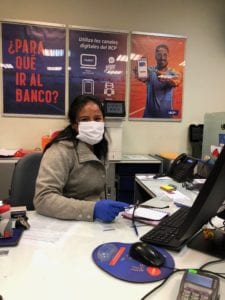
After waiting in a single file line for 20 minutes, or at least the Peruvian version of a single file line, I enter the BCP bank, greeting the bank teller, whose familiar face is hidden behind a white mask. Her hands are covered with blue gloves and there is a cordon separating her from us clients. I type my bank card code on the machine and quickly sanitize my fingers. Ithank her for coming to work. She smiles, “Que tenga buen dia, Señor.”
We stop by the gas station or “grifo” to buy snacks. She happily spends S/160 ($48) on American chocolates and Pringles to share with the other four guests. Then turning to the masked cashier, she asks for a cerveza corona. “Lo siento, la policía nos dijo que no podemos vender alcohol.” We joke, “maybe we shouldn’t have asked for a corona beer.” Apparently, there really is an alcohol embargo.
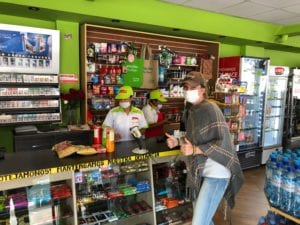 The police are taking this quarantine seriously. I tease the cashier that all the chocolate we just bought is far more dangerous than a couple coronas. She smiles, “Que tenga un buen dia.” Loading up our bags with snacks, we walk up the main Mariscal Castilla street which is completely desolate. We turn left down the cobblestoned Jirón Comercio towards the Plaza de Armas. My legs are tired from my first long walk in a month and I attempt to sit down on one of the plaza benches. A policeman blows his whistle. “Sigue, no más. No pueden sentarse aquí!” The only people in the plaza are police and a woman washing her hands at a sanitary station. I’m truly impressed with Peruvian efforts to contain the virus.
The police are taking this quarantine seriously. I tease the cashier that all the chocolate we just bought is far more dangerous than a couple coronas. She smiles, “Que tenga un buen dia.” Loading up our bags with snacks, we walk up the main Mariscal Castilla street which is completely desolate. We turn left down the cobblestoned Jirón Comercio towards the Plaza de Armas. My legs are tired from my first long walk in a month and I attempt to sit down on one of the plaza benches. A policeman blows his whistle. “Sigue, no más. No pueden sentarse aquí!” The only people in the plaza are police and a woman washing her hands at a sanitary station. I’m truly impressed with Peruvian efforts to contain the virus.
Tuesday, March 24, 2020
Antonia, my head of staff, and I meet to discuss the imminent changes to our staff schedules due to Peru’s quarantine. She is remarkably understanding and agrees with my decision to reduce everyone’s workload equally. We will still have 19 staff working half time with no guests so we will have to think of creative things for them to do. If my mother were here, she would undoubtedly give them a new construction or gardening project. I’d still like to build a structure to support 30 solar panels. Although we won’t be able to make the investment go “net zero” this year, we can at least start building the infrastructure. We agree that tomorrow we will break the news to the staff. Antonia says they will understand and be grateful to keep their benefits and enough salary to cover their expenses. “Ya veremos,” I smile. People react in different ways to fear and uncertainty. Some our staff have challenging conditions at home with extra financial demands. Fortunately, most of them have no debt, own their homes, and don’t lack food, childcare, or family support. I worry more about the majority of Americans who live paycheck to paycheck. I’ll try to keep things light hearted and positive. There is still plenty of good news. We are all healthy and well provided for. Most of the groups that cancelled are rescheduling for 2021 which means that next year should be a good one. And unlike many other small hotels, we have the resources to keep our staff employed for as long as possible. And while looking for a silver lining to share, Pachamama decided to provide one, outside my window……..
Update: April 28th
In the Andes, like the rest of the world, we are living in strange times. After well over a month of quarantine in Peru, most Peruvians are feeling the pain of the state of emergency, the social distancing, and the complete country-wide lock-down. To show solidarity with the hundreds of leaders who have brought yoga and wellness groups to Willka T’ika and the thousands of guests who have visited our Healing Center over the last 25 years, we wanted to send you a candid update on how things are looking from our corner of Peru’s Sacred Valley of the Inca.
The Last Month:
Fortunately, our remaining guests were safely evacuated by the US Embassy on one of the last flights out of Peru on April 2nd. Since then the initial two-week quarantine has been extended three times, and will (hopefully) end on May 10th, allowing much of the country to go back to work. Many Peruvians, especially in the Sacred Valley, rely on tourism and the informal income it provides. Thus they are all particularly struggling with this total disruption to their livelihoods. Hotels, restaurants, and stores are completely closed. Only pharmacies, hospitals, and banks remain open. In Urubamba, our main mercado de abastos is open for only a couple hours each morning and access is strictly controlled. To buy basic provisions, we must don face masks and request permission to cross a military road block. No cars or moto-taxis are allowed, so essential errands must be done on foot or by bicycle. Fortunately, these strict measures have largely been successful and the spread of COVID-19 has been relatively well contained in Peru.
Because we grow our own produce at Willka T’ika, we have been able to feed ourselves by harvesting and preparing our own vegetables, with only occasional forays out to buy provisions. We’ve also been able to share our organic crops with our staff, their families, and local philanthropic organizations such as the Niños del Sol. Keeping our staff employed is our number one concern. As many of you know, most our 19 Quechua staff have been with us for two decades, and each of them supports large families within our small community of Rumichaka. Although we have had to reduce everyone’s hours, we have committed to keeping all of them all on payroll, with full benefits, for as long as possible.
 Vegetable Gardens at Willka T’ika
Vegetable Gardens at Willka T’ika
Looking Forward:
Experts from Turiweb and PromPeru are anticipating that international travel will likely return to Peru later this year. This scenario means very little income for at least several months for most of the local population. The Peruvian government has issued a massive stimulus package, equivalent to 12% of GDP, which includes cash handouts, tax breaks, loans, and health-care spending. This week, local Urubambinos have been queuing up outside the banks for hours, waiting to collect their stimulus check or “bono.”
Assuming there will be little inbound tourism until the quarantine in Peru ends, we are embracing other activities to do in the Sacred Valley to keep ourselves and our staff engaged and productive during the quarantine. In addition to growing and distributing our organic vegetables, we have begun producing essential oils from the rosemary, lavender, muña and ruda that we grow in our gardens. Our distilling machine was designed by our founder, Carol Cumes, two years ago and now is the perfect time to put it to use. We’ve already made a few batches this month and the oils are robust and redolent. It takes 3 of our staff 2 days to harvest, prepare and produce one small jar of essential oil but I’m sure we will get more efficient with practice!
Another new initiative will to be to turn our attention towards the domestic tourism market. There are millions of Peruvians who have been cooped up in their city homes and would benefit tremendously from a restorative retreat to the Andes. As such, we are offering a special wellness package for Peruvians which we hope to launch as soon as domestic flights re-open from Lima to Cusco. We also wish to deploy some of the funds that our generous donors have contributed to the Willka T’ika Children’s Fund. In addition to supporting our local secondary schools and providing scholarships for their graduates to attend university in Cusco, we’d like to provide relief to other communities in need in the Sacred Valley and in the mountain community of Q’eros. Feel free to reach out to us if you have ideas and suggestions.
We remain optimistic for Peru, tourism, and especially for wellness travel. Once it becomes safe to travel again, people around the world are going to want to invest in their own health and in destinations that help heal the planet. Willka T’ika will be waiting for you as soon as you are ready.
The following free resources are courtesy of Willka T’ika’s retreat leaders, friends, and inspiring generous teachers:
With gratitude for helping us stay grounded….
Relaxing to Alexandre Tannous’ amazing sound meditations
Listening to Dennis McKenna’s inspiring tribute to his brother Terence
Exploring meditation for leaders with Jack Kornfield and Tara Brach
Home Yoga Practice sequences courtesy of Baxter Bell and Romi Cumes.
Update: May 20th
We continue to feel blessed to be in the Andes, where the corona virus is relatively well contained. Lima, the Amazon, and other regions have not fared so well. Some say the Andean resilience is related to the increased lung capacity of the local Quechua. Our staff are quite fond of this theory. But it’s too early to be sure of anything and in the Sacred Valley we are doing our best to continue to shelter-in-place, which will likely be extended again after May 25th.
Fortunately, we have kept busy producing flower essences. We know have dozens of 100% pure, 10ml vials ready to sell and share with our past and future guests. (There are no present guests, of course!). In order of quantity, we have eucalyptus (very popular now for its respiratory benefits), muña (our favorite Andean mint), ruda (an intoxicatingly powerful healing plant), lavender (great for massages), and rosemary (all around lovely). We are also experimenting with geranium, basil, oregano and lemon verbena (cedroncillo). Let us know if you’re interested.
In the office, we’re busy with a few exciting promotions for our group leaders and individuals who are making plans to come as soon as international flights open, which could be as early as August or as late as October. (Note: this forecast changes literally every day.) One fun, new promotion was just featured on BuzzFeed and lists Willka T’ika as #15 in the world for hotels offering a Buy Now, Stay Later Hotel Bond. We know so many people who are dreaming about traveling. Hopefully, these incentives will make those dreams come true as soon as possible.
And the most exciting news of the month was that we all got haircuts! In order to keep the staff safe, we hired our local barber to come and cut about 15 people’s hair.
Update: June 2nd
The national state of emergency and quarantine in Peru have been extended until June 30th. Although this is challenging for those of us who rely on tourism for our livelihoods, we feel grateful to be here in the Sacred Valley. To have all of our 19 Peruvian staff close by, healthy, and still employed is a huge blessing. I like to think of us as “Sheltering in Paradise” because even though the Coronavirus has spread to South America, the Sacred Valley is still well protected. In our small community of Rumichaka, we keep close to home, cook healthy meals together, and enjoy the beautiful Andean weather. We also manage to keep surprisingly busy! As Carol Cumes has done for 25 years, we continue to find creative projects to occupy ourselves: first producing essential oils and now building a Temescal and a ritual bath. When our guests return, we will be able to offer sweat lodges, cold plunges, and cacao ceremonies in addition to the Andean ceremonies we have been organizing with Don Benito for decades!
Many of you have asked if you could purchase our newly distilled essential oils. You are welcome to pre-order some for a debut price of $25 for 10ml and $50 for 30 ml (not including shipping). This special price will hold as long as our quarantine does, and the funds will help support our staff and their families. To reserve your order, please email: essentialoils@willkatika.com
Now for the big question: When will travel to Peru resume?
Well, we ask ourselves, our partners, our vendors, and government officials every day and the truth is — nobody really knows. In the last week alone, we’ve heard everything from “late this summer” to “not until 2021.” For those of you with an upcoming retreat to Peru, we empathize with your concerns. All we can say is that we will be as flexible as possible and allow you to change your bookings without penalties, whenever possible. We are preparing ourselves to welcome Peruvians this summer, and international travelers this fall. Peru takes its health protocols very diligently, and we have been training our staff in post-Covid standards. Before flights resume, we are committed to having all the latest (and constantly evolving) health requirements securely in place.
If you want to talk about your plans or about what’s happening in Peru, feel free to call us at 888-737-8070 or +1 805-884-1121. We are with you for the entire journey.
Update: June 22nd
 We’re still hoping that the national state of emergency and quarantine in Peru will end next week, June 30th. Plans are already being made for domestic travel to resume in mid July, which means that we hope to open our doors to travelers from Lima and other cities. We’re in the process of finalizing our SI-COVID plan so that we have all health protocols in place as per the Ministry of Health (MINSA). In the meantime, we are continuing our distillation of essential oils, even though some sources close to us are saying that these oils are not truly essential!
We’re still hoping that the national state of emergency and quarantine in Peru will end next week, June 30th. Plans are already being made for domestic travel to resume in mid July, which means that we hope to open our doors to travelers from Lima and other cities. We’re in the process of finalizing our SI-COVID plan so that we have all health protocols in place as per the Ministry of Health (MINSA). In the meantime, we are continuing our distillation of essential oils, even though some sources close to us are saying that these oils are not truly essential!
Update: July 15
Today was a big day for travel in Peru. As of this morning, domestic flights are officially allowed to carry travels between Peruvian destinations. Flights from Lima to Cusco can now be found for as low as $14. Of course, it is still too early to tell if the national tourism market will kick-start as PromPeru (and all of us) hope. Although Cusco and the Sacred Valley are still relatively unscathed, COVID-19 is still spreading in some cities in Peru and Lima remains a concern. We are still optimistic and have begun receiving request from Peruvian travel agencies and individuals who are ready for an Escape to the Andes, especially at once-in-a-lifetime prices.
Most importantly, we have finalized our internal health and safety plan. See here for our detailed PROTOCOL FOR THE PREVENTION AND CONTROL OF COVID-19 IN THE HOTEL. If you have any questions about any of the protocols, feel free to e-mail us at info@willkatika.com.
The the Lima Airport is now officially open: For a helpful video (in Spanish) see this link.
And to see how airlines are innovating to make air travel safe see this link.
Update: July 26
This week our first guests from Lima arrived. This family, like many others in Lima, was being completely confined to their homes for 4 months. They couldn’t be happier to finally be in the soothing Sacred Valley. They plan to stay with us for a month, maybe longer. Next week another family from Lima will be arriving and we expect this trend to continue as Limeños are now finally able to travel. They shared that the safety precautions at both the Lima and Cusco airports are impressive and everyone was required to travel with face protectors, face masks, and an affidavit of health. Moreover, any guests who arrive at Willka T’ika also have to undergo our rigorous health and safety protocols.
Our partners at Explorandes recently published this helpful update on the status of flights in Peru:
Re-opening of flights
Last week the government finally gave the green light to restart domestic flights after the airports, airlines and the government were able to align the sanitary measurements that each should follow. Finally, on July 15th domestic flights departed from Lima´s Jorge Chavez airport to different cities including Cusco, Juliaca and Ayacucho. Although the first day was somewhat chaotic, operational adjustments have been made to improve the efficiency and order of the different checkpoints. All airlines have implemented the High Efficiency Particulate Air (HEPA) filters which eliminate 99.5% of all particulates over 0.3μm and completely renew the air inside the aircraft every 3 minutes. Additional measures taken by the airlines include passengers having to sign an affidavit declaring non-presence of symptoms, temperature control, social distancing throughout the check-in process, contactless check-ins with pre-printed or mobile boarding passes, disinfecting shoes and hands when boarding the plane and obligatory use of facemasks and face protectors throughout the flight. With these measures in place and the low expected demand, none of the airlines are restricting capacities or flying with empty middle seats.
International flights are set to reopen during phase 4 of the economic reactivation plan. There is unfortunately, very little information about what will happen. We are expecting this to be a slow process with likely setbacks and where borders are progressively opened with countries that already have their own borders open such as Chile, Brazil, Mexico, and the United States. There is a push by the regional government of Cusco to receive international flights from Santiago, La Paz and other nearby cities that can connect to other markets in the US and Europe. We still have no news regarding protocols for receiving foreign travelers.
Update: August 6
The latest update from a very helpful expat blogger living in Cusco and from Amazonas Explorer:
There’s a chance that Cusco will return to a full quarantine starting on August 10.
Covid-19 numbers have continued to climb, which has led to a state mandated quarantine and has shutdown all national flights to Cusco until August 31st, which will be extended if the cases continue to climb and the medical systems continue to overwhelmed.
Regarding the reopening of Machu Picchu, the local tourism committees have decided to delay the reopening of Machu Picchu.
Update: August 24
The latest update from Amazonas Explorer:
The Cusco area remains under quarantine as the number of cases continue to rise. National flights to the Cusco area remain cancelled until the number of reported cases and the occupancy of hospital beds begin to decline.
The Minister of Transport and Communications has recently announced that International flights will continue to remain closed during Phase 4 “The Reactivation of the Economy” and only travel for healthy, study or work purposes will be allowed. This pushes international flights to 2021, but as we’ve seen this could change.
The government has officially released the new “Safety Protocols” for the Adventure Sport industry in the Tourism sector so that operators can begin operating their adventure sport outings again.
Machu Picchu has still not been assigned a tentative opening date, and will not be assigned one until the number of Covid-19 cases begin to decline in the area.
Update: September 29
Another helpful update from Amazonas Explorer:
October 1st marks the beginning of Phase 4 in Peru
President Vizcarra announced that international flights will be reactivated October 5th. Over the weekend the specific details of when, where and how was released.
Flights will be filled at 100% occupancy.
The initial destinations will be: Mexico, Chile, Ecuador, Colombia, & Brazil (only Sao Paulo).
To leave the country travelers will be required to show a negative molecular test within 48 hours of taking the test.
The number of international flights per week will be just under 21% of pre-Covid number of flights per week.
The State of Emergency will be extended until October 31st 2020.
And from Explore Cusco:
Both Andina News and Cusco Post are reporting that the Cusco region will begin the economic and tourist reactivation with free visits for Cusqueños to the 47 registered tourist districts, among them Machu Picchu, to then allow the entrance to the national tourists and, finally, to the foreigners, as announced yesterday by regional governor, Jean Paul Benavente Garcia.
He specified that the visits will be from October 5 and will include Machu Picchu, the 16 attractions offered by the Tourist Ticket and others, with strict compliance with health protocols to prevent the spread of the new coronavirus.
Update: October 12, 2020
As international travel begins to open up, we’ve been following the US Travel Advisory Information for traveling to and from Peru. We’re hoping some flights to the US will open this month.
As of October 5th international flights opened to 7 regional countries: Ecuador (Quito, Guayaquil), Bolivia (La Paz, Santa Cruz), Colombia (Bogotá, Cali, Medellín), Panama (Panama City), Uruguay (Montevideo), and Chile (Santiago). Based on how things go this week next, other destinations will follow. Passengers are required to wear masks and face protectors and must have a negative molecular test within 72 hours of boarding inbound flights. Foreigners landing in Peru will be asked to sign an affidavit that they are in sound health and will voluntarily quarantine upon arrival. Travelers with Covid-19 symptoms are required to report them to the Ministry of Health (MINSA).
Regarding Machu Picchu, according to regional director of Foreign Trade and Tourism (Dircetur), Machu Picchu will open on October 15. This date has been a moving target over the last month so best to check regularly on Explore Cusco or Amazonas Explorer, among other reliable sources. Fortunately, several other famous ruins around Cusco have recently been opened:
The State of Emergency is still scheduled to be extended until October 31st 2020.
Update: October 19, 2020
Peru continues to open slowly and incrementally. Sunday curfews have been lifted in many locations. International flights continue to 7 regional destinations. Over 4000 people arrived in Peru the first week that international borders opened after October 5th. And as of October 15th, the following Incan ruins around Cusco are now open to the public: Saqsaywaman, Pisaq, Ollantaytambo, Chinchero, Tipon, Moray, Pikillaqta. Since all of these ruins are within a 1.5 hour drive of Willka T’ika, this is great news for our guests (and for us!).
More good news: Machu Picchu ticket sales open today for Peruvian nationals and we are planning to take the entire Willka T’ika staff in the next two weeks. Everyone is hoping that this will open the path to foreign arrivals in November as most travelers want to be sure they can see Machu Picchu before booking travel to Peru. Initially, admission will be restricted to 675 visitors per day in small, guided groups. Normally, there are over 2000 visitors per day making this a unique opportunity to see the ruins in a more peaceful setting. We will continue to update this blog weekly.
Update: November 14, 2020
Despite the recent political crisis in Lima, things have been progressing positively in the Sacred Valley. Tourists from Lima have been arriving in increasing numbers and are so happy to rest and recover in our Chakra Gardens. We are one of only 3 hotels to have been operating for several months and have thus refined our safety protocols to the point that they are becoming second nature. Although the case load in the Sacred Valley is very low and Cusco has made huge improvements, the locals are still very careful, and wearing face masks has become a habit for everyone. Our recent guests from Lima report that flights to Cusco are 70% full and that domestic air travel had not been tedious. The biggest complaint has been wearing a face protector for the entire duration of the flight.
As for international travel, it has begun to trickle in, but it is still too early to know how smooth this will be for our groups from the US and Europe. Americans are required to have an affidavit that shows a negative COVID-19 test within 72 hours of their travel date but quarantining is not required upon arrival. So it seems for now, the hardest part will be getting to Peru. For helpful information on testing, see this NYT article.
Regarding Machu Picchu, in honor of its official re-opening on November 1st, we took the staff of Willka T’ika on a 1 day Inca Trail from Km 104 to Machu Picchu. The weather was mild and the trail was very quiet. We were treated to a tour of the citadel with only minimal crowds, and plenty of staff reminding us to keep our face masks on — no small feat when climbing steep steps! Now is truly a special time to visit the Incan sanctuary with only 630 tickets sold per day (about one-third of the current capacity).
Check out this video that our guide made of the Willka T’ika staff hiking from Km 104 to Machu Picchu’s Sun Gate a couple weeks ago. It will give you a sense of what it’s like to visit Machu Picchu with much fewer tourists but many more facemasks. (Note, we had the facemasks on almost the entire time, only taking them off for photos and for especially steep sections of the Inca Trail!)
Update: December 2, 2020
Today Willka T’ika receives its official certificate of safety from the Urubamba Municipality. We were among the first 3 hotels in Urubamba certified as #SafeTravels Destination by the @world_traveltourism council. So today is like Graduation Day!
Our international guests are starting to arrive. This Friday some of our return guests from New York will be joining our new Essential Wellness Retreat. This new program was designed for Peruvians wanting to escape from the cities for some healing and restoration in the Sacred Valley. Now we are offering the same program to our international guests. Before booking your flights, make sure to read the following Travel Advisory from the US Embassy in Lima.
Guidelines for International Travel to Peru: New international travel guidelines to enter Peru are in flux, currently requiring that inbound international passengers on commercial flights have either a negative real-time COVID-19 molecular (RT-PCR), negative antigen test result, or a medical certificate of epidemiological discharge that is no more than 72 hours old after being issued, before boarding the plane. Children under the age of 12 can present a certificate of health issued by a medical doctor in lieu of a negative test. All passengers must also complete an affidavit of health (found here: https://e-notificacion.migraciones.gob.pe/dj-salud/). These requirements may change, so we advise you to contact your airline days prior your flight to gather the proper documentation and regularly consult the airport website for the latest guidance: https://www.lima-airport.com/eng/for-passengers/covid-19-protocol/arrival-protocol (in English) and https://www.lima-airport.com/esp/para-pasajeros/protocolo-covid-19/antes-de-viajar (in Spanish).
And more good news: the COVID statistics in Peru continue to improve: https://explorecuscoperu.com/2020/12/03/end-of-november-covid-update-for-peru/
Update: January 11, 2021
We finally traveled from Peru to the US and are heading back to Peru this week. So although travel restrictions are changing daily, we wanted to share with you what we have learned.
This information is from the on American Airlines travel website: (Other airlines should have similar info). We traveled from Lima to Miami to San Francisco on American Airlines and felt very safe and comfortable with how the COVID protocols were handled.
They provide the following 3 types of documentation to review and prepare before traveling to Peru:
1) Info from US Embassy: There is a lot of important info here and links to State Dept, etc.
2) Health Declaration Form. You should review both of these links on the AA site:
On-line Form that should be submitted in advance. You need to print and have the QR code handy to show upon arrival.
In section I, where it says “teléfono de contacto” this refers to your phone number. If you are quarantining in Willka T’ika you might use our office number: +51 084-201-508
In section II, leave blank if you are not a resident in Peru
In section III, if you are staying with us, you would list Urubamba as the city, Willka T’ika as the hotel, and Paradero Rumichaka as the address.
In section IV, you would need to check “no” in the first box (no contact with COVID), and not check any of the symptoms. Then sign and date to show that this is an official legal document, hence a “declaración jurada”. Have a copy with her as they will ask her for this before boarding, on the plane, and upon arrival.
3) Proof of Negative COVID test
It offers this Peruvian document with all the bureaucratic details but it doesn’t say if the results should be uploaded or not. Again, have a copy of the test results (RT-PCR, negative antigen test, or medical certificate of epidemiology) that is less than 72 hours before boarding. It’s always good to have copies of all relevant documents on hand. Please check the links above regularly as they WILL change.
Update: January 20, 2021 – Getting back to Peru
We made it! Travel back to Peru turned out to be pretty smooth. (Note we are Peruvian residents so the following may not be the same for non-Peruvian residents.) The flights on American were far from full and the flight attendants were very helpful making sure we had a full row of seats to ourselves. Everyone wore their masks and some of us (those used to traveling in Peru), had full face protectors. We arrived in Lima at midnight and the airport was refreshingly quiet. The only glitch we had was our On-line Health Declaration Form. Apparently we had not uploaded it correctly and they wouldn’t let us pass Immigration without it! We had all the other forms printed out and the Health Ministry Form that even looked just like the Immigration Form they needed. Nonetheless, they take their forms very seriously and I’ve learned over the years that if you are patient and keep smiling you can usually find a solution. Fortunately, they were able to help us upload the form from our phones and then take a photo of the on-line form for the officer. They also reviewed our negative Covid tests, reminded us about the new 14 day quarantine, and asked us for the phone number of our hotel. We’ll obviously be quarantining at Willka T’ika so it will be interesting to see if they follow up with us. Since we had 5 hours until our connecting flight, spending an extra hour at Immigration didn’t seem like a big burden. That said, don’t make this mistake and double check that your on-line form was submitted 72 hours prior to departure AND that you have a printed copy of it! Our luggage was still waiting for us when we cleared and a lone attendant had taken the trouble to collect it for us. We went to change dollars so that we could tip him 5 soles.
Normally, we would go straight to the LATAM counter and check in our baggage for Cusco but since Jorge Chavez Airport is very quiet these days, there was noone at the National Terminal Counter until after 4AM! This was a bit concerning since our Cusco flight was supposed to board at 4:30AM but nobody seemed worried. Again, flights were empty so we wouldn’t need much time to clear security. While we waited, we went upstairs to the food court where people were spread out on socially distant chairs. The airport Wifi was good so we were able to work for a couple hours. By 3AM we went back to the LATAM counter, making sure we were first in line. By 4:15 we had checked our bags onto our LATAM Cusco flight. Incidentally, American charged us $65 for extra bags (plus $100 if over 50 pounds, $200 if over 70 pounds!). LATAM charged us $60 per bag and another $60 for overage. We had a lot of bags!
Normally arriving in Cusco baggage claim, you are bombarded by porters trying to help you with your bags. This time the airport parking lot was empty and they were not letting any cars through, ostensibly to enforce social distancing? This means we had to load up our own bags on a couple carts and push them through the parking lot outside onto the busy street. Not ideal, especially if the goal was to reduce congestion! Our driver tried to help us collect the bags but he could only get so far inside so we had to shuttle our 5 suitcases to his van. Fortunately everyone kept their masks on outside but we had to wade through dozens of taxi drivers offering 10 soles to drive us to town. I would have rather paid them 10 soles to help us with our suitcases. Peruvians (at least in the Andes) have done a good job following social distancing and mask guidelines. But with talk of a second wave of Covid, we are going to make extra sure that all our Peruvian guests continue to follow protocols.
Update: February 20, 2021
The Peruvian government extended the State of Emergency for 180 more days through Supreme Decree No. 009-2021-SA. The extension of the emergency goes until September 2021. This is not a surprise as the Peruvian government has continued to extend this “Health” State of Emergency to allow it to have more flexibility with regards to emergency spending and for enforcing the various and constantly evolving rules and protocols. This doesn’t change much for us in the Sacred Valley as we are more affected by any updates to Quarantine regulations which vary by province. In the Sacred Valley, there is still a “toque de queda” or curfew on Sundays and after 8PM but taxis (with permits) and public transportation are still operating normally and most restaurants remain open at reduced capacity. The main change this month is that ruins are closed to the public. Machu Picchu is expected to open by early March and if that happens, other tourist sites will likely follow. As before, for more details, we recommend reading the recent updates here and checking Peru and US news source daily and information is constantly changing.
Good news: It is now possible to get an Antigen test right here in Urubamba at Clínica Cima for S/150 ($40). The nasal swipe test is offered several days each week and results are available within 20 minutes. We had one guest go yesterday in preparation for her flight back to the US on Monday. For those of you planning to travel to Peru in the next month, see our update on January 11th for the steps to take before flying to Peru. So far none of our guests have had any issues getting here.
Update: March 30, 2021
The last few weeks we’ve been thrilled to welcome guests from the United States, Canada and even Russia. All of them were able to fly into Lima and connect through to Cusco without any issues. As per our instructions above, it is still essential to have a negative Covid test and to keep all required documentation on your person while traveling.
More good news: Peru has lifted the quarantine requirement for inbound travelers with a negative antigen test. If you read the US Embassy information carefully, you will notice this important update:
Quarantine Information: Are U.S. citizens required to quarantine?
As of March 15, 2021, the Government of Peru announced that travelers who take an antigen test and receive a negative result after their first day of arrival may suspend the 14-day quarantine requirement. Travelers may take an antigen test at the airport, a local hospital, or any laboratory authorized by the Ministry of Health (MINSA). Travelers who test positive must complete the 14-day quarantine at either the Pan-American Village or location of their choice in coordination with health authorities. The approved MINSA labs can be found here: http://www.digemid.minsa.gob.pe/main.asp?Seccion=967. Find more information in the decree, online here (in Spanish): https://busquedas.elperuano.pe/normaslegales/decreto-supremo-que-establece-precisiones-y-modifica-el-decr-decreto-supremo-n-004-2021-pcm-1919992-1/.
Local health officials and law enforcement are authorized to ask travelers for proof of a negative antigen test; therefore all U.S. citizen travelers are advised to keep their results on hand in case they are asked to present them.
Travelers are responsible for funding their own COVID-19 testing and quarantine costs.
Willka Tika Covid Protocols Summary
Willka T’ika Covid Protocol Video

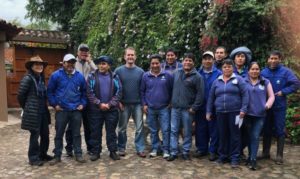
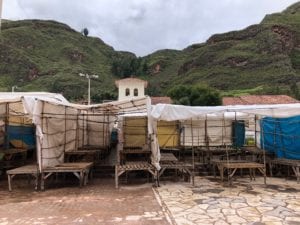
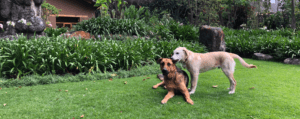
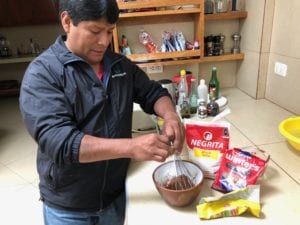
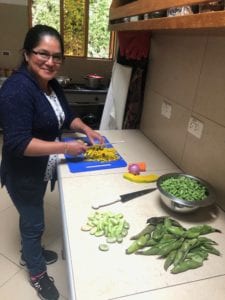

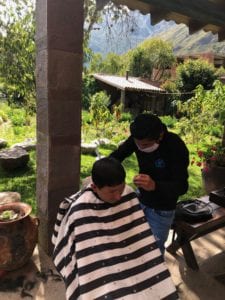
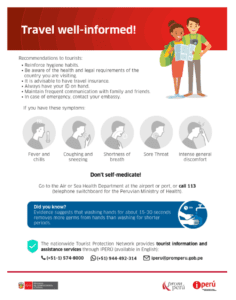
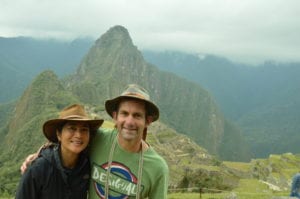
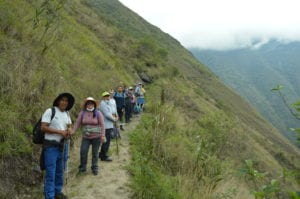
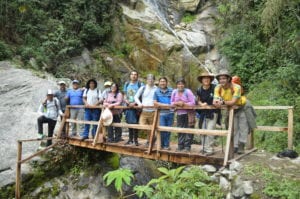

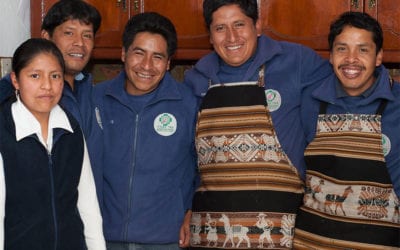
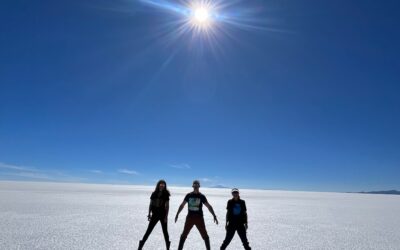
Recent Comments